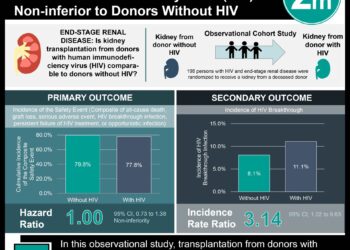Double-unit cord-blood transplantation does not aid survival in children with hematologic malignancy
1. In children with hematologic malignancy, there was no significant difference in terms of 1-year survival between single- and double-unit cord-blood transplantation groups.
2. Children who received double-unit cord-blood transplantation were more likely to experience delayed platelet recovery and graft-versus-host disease.
Evidence Rating Level: 1 (Excellent)
Study Rundown: Unrelated-donor umbilical-cord blood is a potential source of hematopoietic stem cells for transplantation in patients with hematological malignancies. The advantages include rapid availability, absence of donor attrition, and a reduced risk of graft-versus-host disease (GVHD) compared to traditional stem cell transplantation. However, there is a limited number of hematopoietic progenitor cells in a single-unit of cord-blood, which restricts use to children and smaller adults. A previous study had found that double-unit cord-blood transplantation was promising in terms of reach the desired cell dose in patients with larger body surface area.
This study was designed specifically to address whether two cord-blood units are better than one in children diagnosed with hematologic malignancy. The authors randomized patients aged 1 to 21 years who had been diagnosed with hematologic malignancies to receive either single- or double-unit cord-blood transplantations following a standardized myeloablative regimen and prophylaxis for GVHD. In the intention to treat analysis, there was no significant difference in terms of 1-year survival between single- and double-unit transplantation groups; there was also no significant difference in terms of disease-free survival, incidence of relapse, or treatment-related death in either group. However, patients who received a single-unit of cord blood experienced platelet recovery significantly faster, and there was a higher incidence of grade III and IV acute GVHD and extensive chronic GVHD in the double-unit recipients.
The primary strength of the study is its well-powered, randomized design, with a direct comparison between double- and single-unit recipients, which lends credence to the conclusion that double-unit cord-blood transplantation does not confer a survival advantage in children and adolescents and carries a higher risk of delayed platelet recovery and GVHD. The greatest weakness is that the negative findings cannot be generalized to adults, who were excluded from the study, and who might generally be the likely candidates for double-unit transplantation (given their greater body surface area).
Click to read the study, published today in NEJM
Relevant Reading: Umbilical cord blood transplantation: the first 25 years and beyond
In-Depth [randomized controlled trial]: In this study, 224 patients with hematologic cancer, aged 1 to 21 years, were randomly assigned to receive either single- or double-unit cord-blood transplantation. Prior to transplantation, patients were treated with fludarabine and total-body irradiation; they also received GVHD prophylaxis with cyclosporine and mycophenolate mofetil, both were continued after the transplantation. Inclusion criteria required availability of two cord-blood units with adequate cell doses that were HLA-matched both to the patient and each other at 4/6 HLA loci. Approximately 35% of patients were diagnosed with acute myeloid leukemia, and approximately 53% were diagnosed with acute lymphocytic leukemia; the rest were split among other hematologic cancer categories.
The primary endpoint was 1-year overall survival, assessed using an intention-to-treat analysis. There was no significant difference in overall survival between the single- and double-unit cord-blood transplantation groups. The 1-year survival rate was 65% (95% Confidence Interval, 56-74%) in the double-unit recipients, compared to 73% (95% Confidence Interval, 63-80%) in the single-unit recipients (P=0.17 on log-rank test). There were also no significant differences in the disease-free survival, incidence of relapse, or treatment-related death in either group.
Importantly, patients in the single-unit group experienced platelet recovery significantly faster than those in the double-unit group (incidence 76% vs. 65%, P=0.04). Recipients of double-unit transplantation had a higher incidence of grade III and IV acute GVHD (23% vs. 13%, P=0.02) and of extensive chronic GVHD (15% vs. 9%, P=0.05) over the course of follow-up. There were no differences between the groups in terms of infections associated with treatment.
More from this author: Severe subtype of acute lymphoblastic leukemia susceptible to FDA-approved kinase inhibitors, Mepolizumab reduces exacerbations in severe eosinophilic asthma, Long-acting, reversible contraceptive methods linked to lower teen pregnancy rates, Extraordinary response, and resistance, to everolimus in thyroid cancer pinned to mutations, Triple-combo chemotherapy improves survival for metastatic colon cancer [TRIBE study]
Image: PD
©2012-2014 2minutemedicine.com. All rights reserved. No works may be reproduced without expressed written consent from 2minutemedicine.com. Disclaimer: We present factual information directly from peer reviewed medical journals. No post should be construed as medical advice and is not intended as such by the authors, editors, staff or by 2minutemedicine.com. PLEASE SEE A HEALTHCARE PROVIDER IN YOUR AREA IF YOU SEEK MEDICAL ADVICE OF ANY SORT.






